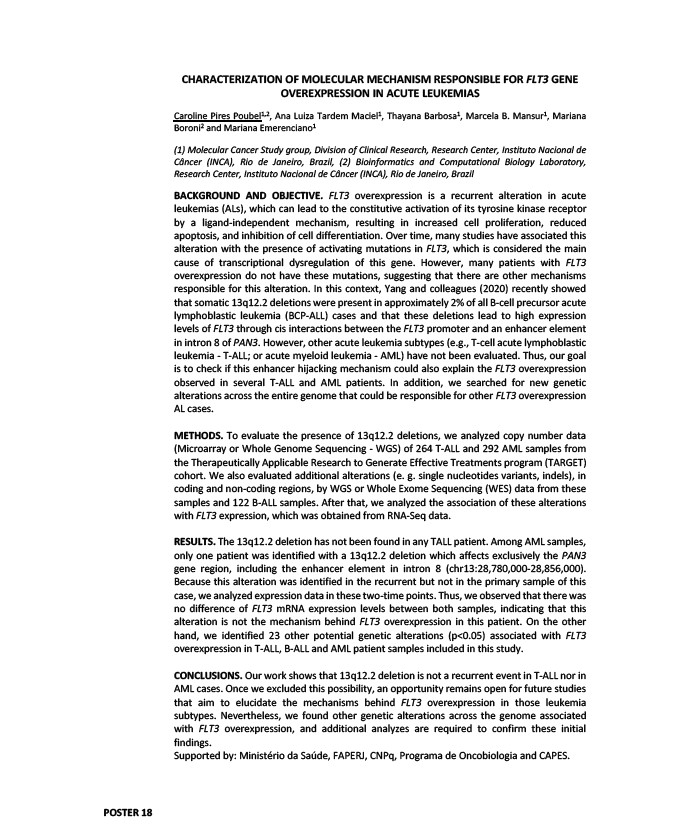
CHARACTERIZATION OF MOLECULAR MECHANISM RESPONSIBLE FOR FLT3 GENE
OVEREXPRESSION IN ACUTE LEUKEMIAS
Caroline Pires Poubel1,2, Ana Luiza Tardem Maciel1, Thayana Barbosa1, Marcela B. Mansur1, Mariana
Boroni2 and Mariana Emerenciano1
(1) Molecular Cancer Study group, Division of Clinical Research, Research Center, Instituto Nacional de
Câncer (INCA), Rio de Janeiro, Brazil, (2) Bioinformatics and Computational Biology Laboratory,
Research Center, Instituto Nacional de Câncer (INCA), Rio de Janeiro, Brazil
BACKGROUND AND OBJECTIVE. FLT3 overexpression is a recurrent alteration in acute
leukemias (ALs), which can lead to the constitutive activation of its tyrosine kinase receptor
by a ligand-independent mechanism, resulting in increased cell proliferation, reduced
apoptosis, and inhibition of cell differentiation. Over time, many studies have associated this
alteration with the presence of activating mutations in FLT3, which is considered the main
cause of transcriptional dysregulation of this gene. However, many patients with FLT3
overexpression do not have these mutations, suggesting that there are other mechanisms
responsible for this alteration. In this context, Yang and colleagues (2020) recently showed
that somatic 13q12.2 deletions were present in approximately 2% of all B-cell precursor acute
lymphoblastic leukemia (BCP-ALL) cases and that these deletions lead to high expression
levels of FLT3 through cis interactions between the FLT3 promoter and an enhancer element
in intron 8 of PAN3. However, other acute leukemia subtypes (e.g., T-cell acute lymphoblastic
leukemia - T-ALL; or acute myeloid leukemia - AML) have not been evaluated. Thus, our goal
is to check if this enhancer hijacking mechanism could also explain the FLT3 overexpression
observed in several T-ALL and AML patients. In addition, we searched for new genetic
alterations across the entire genome that could be responsible for other FLT3 overexpression
AL cases.
METHODS. To evaluate the presence of 13q12.2 deletions, we analyzed copy number data
(Microarray or Whole Genome Sequencing - WGS) of 264 T-ALL and 292 AML samples from
the Therapeutically Applicable Research to Generate Effective Treatments program (TARGET)
cohort. We also evaluated additional alterations (e. g. single nucleotides variants, indels), in
coding and non-coding regions, by WGS or Whole Exome Sequencing (WES) data from these
samples and 122 B-ALL samples. After that, we analyzed the association of these alterations
with FLT3 expression, which was obtained from RNA-Seq data.
RESULTS. The 13q12.2 deletion has not been found in any TALL patient. Among AML samples,
only one patient was identified with a 13q12.2 deletion which affects exclusively the PAN3
gene region, including the enhancer element in intron 8 (chr13:28,780,000-28,856,000).
Because this alteration was identified in the recurrent but not in the primary sample of this
case, we analyzed expression data in these two-time points. Thus, we observed that there was
no difference of FLT3 mRNA expression levels between both samples, indicating that this
alteration is not the mechanism behind FLT3 overexpression in this patient. On the other
hand, we identified 23 other potential genetic alterations (p<0.05) associated with FLT3
overexpression in T-ALL, B-ALL and AML patient samples included in this study.
CONCLUSIONS. Our work shows that 13q12.2 deletion is not a recurrent event in T-ALL nor in
AML cases. Once we excluded this possibility, an opportunity remains open for future studies
that aim to elucidate the mechanisms behind FLT3 overexpression in those leukemia
subtypes. Nevertheless, we found other genetic alterations across the genome associated
with FLT3 overexpression, and additional analyzes are required to confirm these initial
findings.
Supported by: Ministério da Saúde, FAPERJ, CNPq, Programa de Oncobiologia and CAPES.
POSTER 18